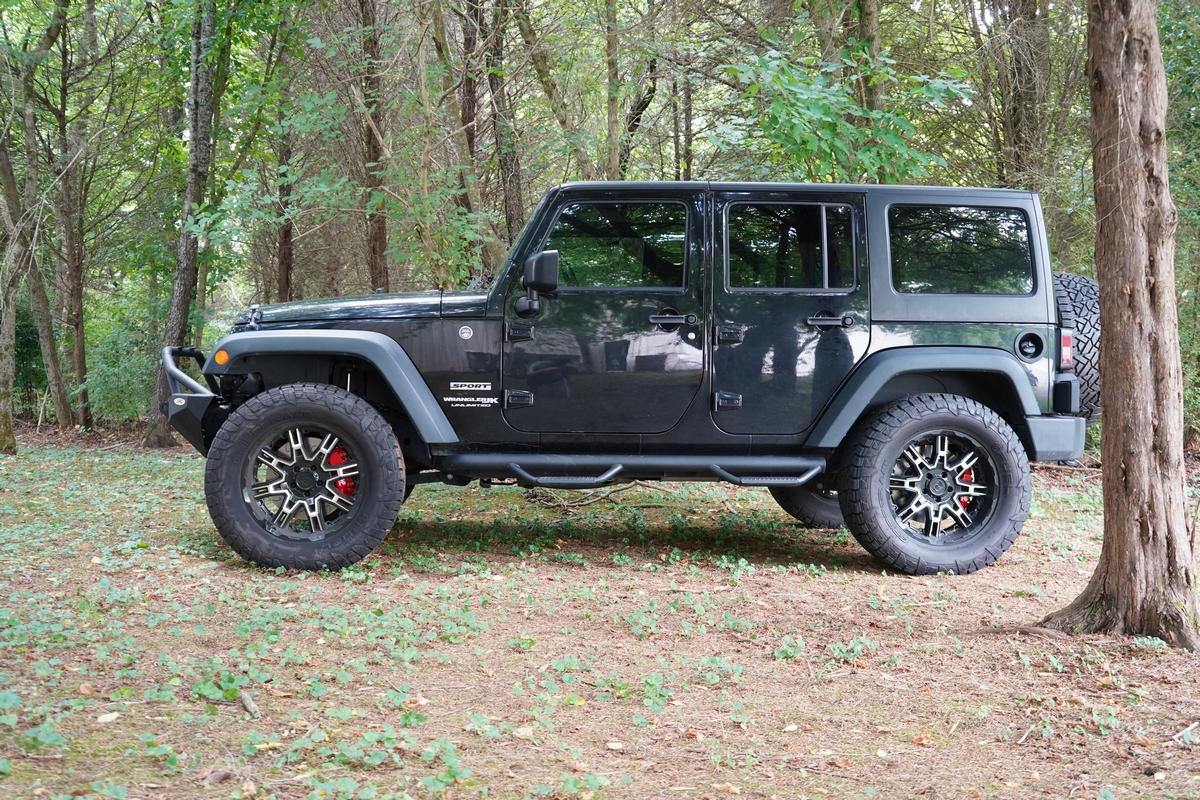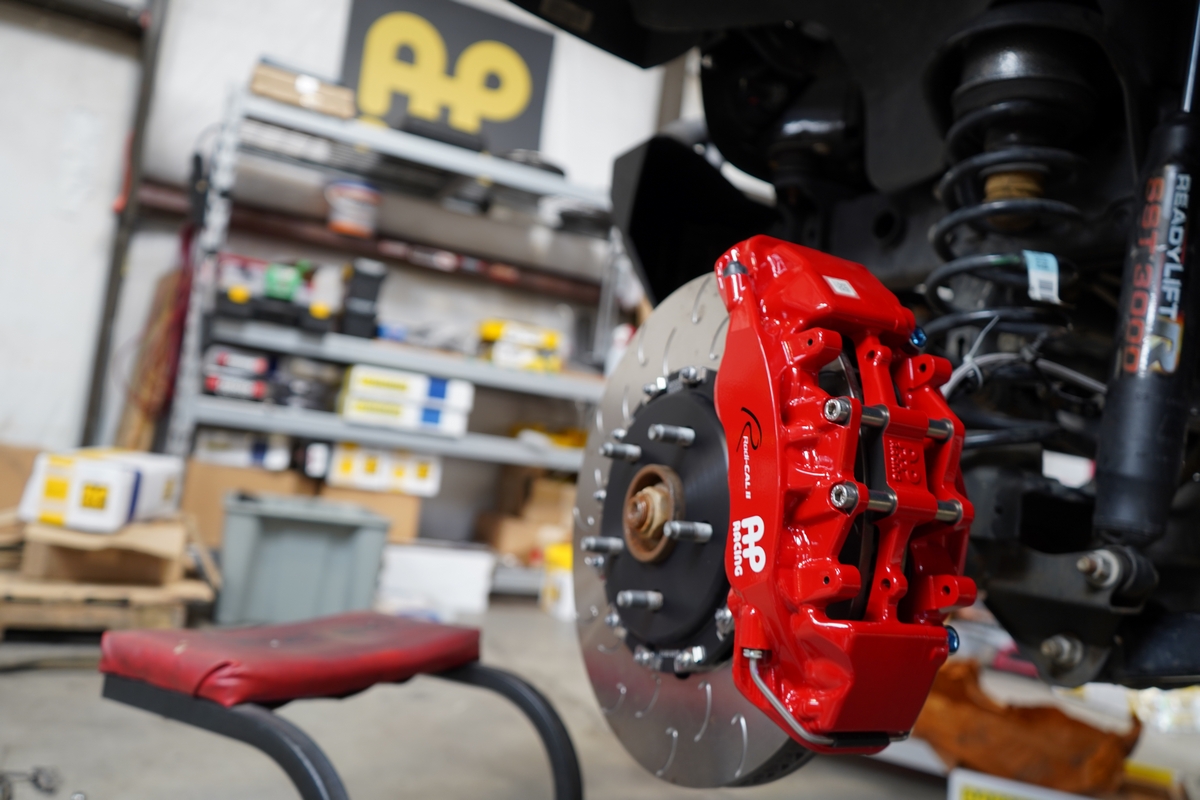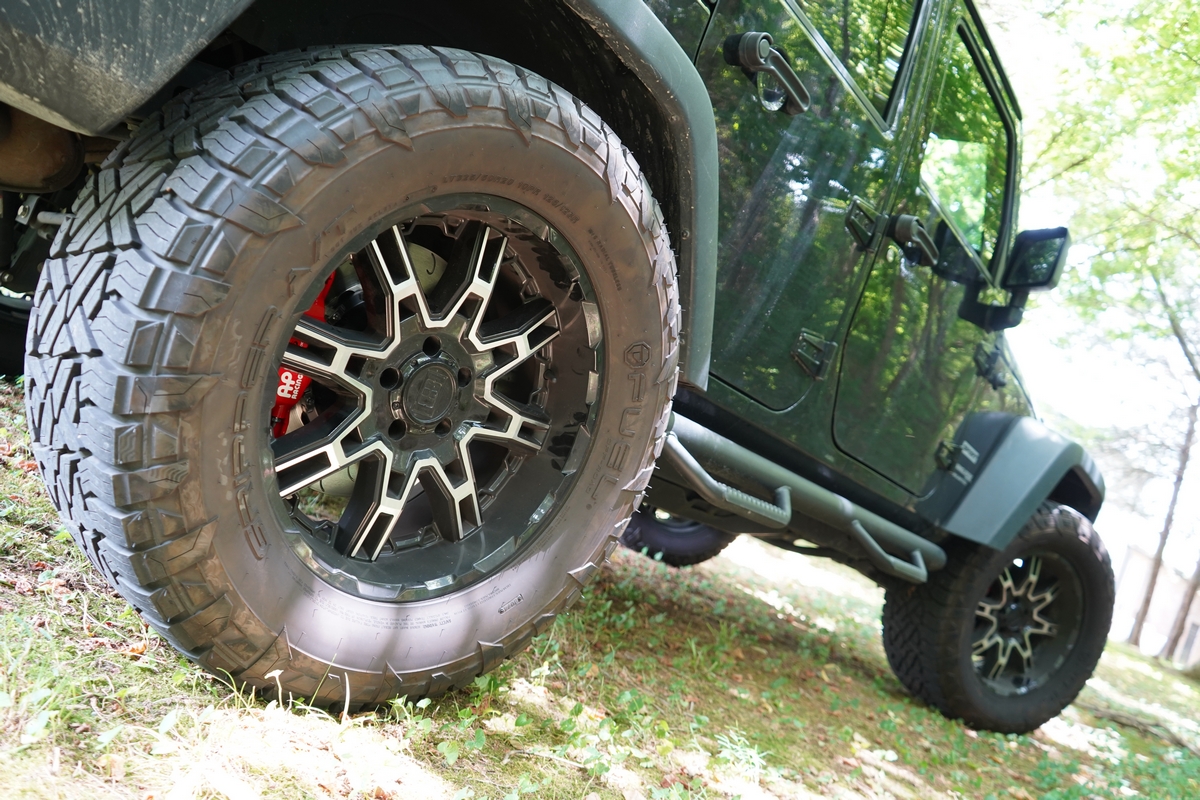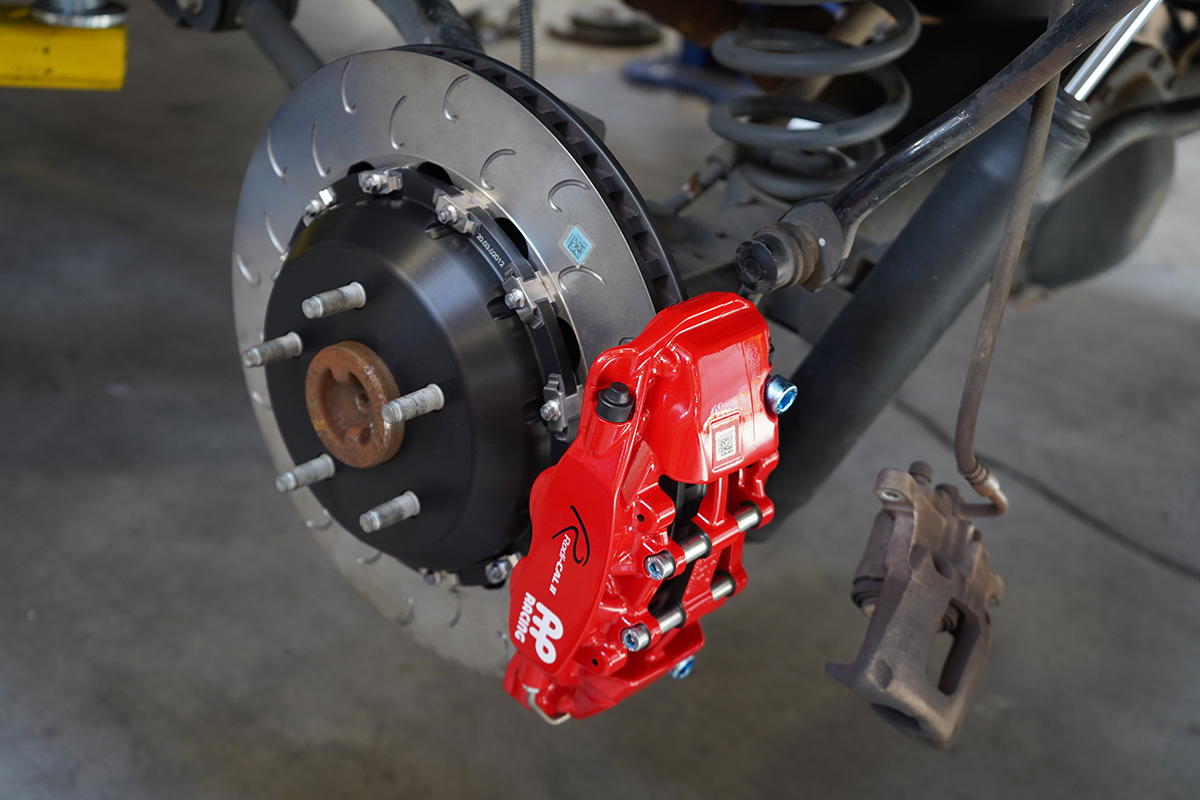Jeep JK: The Case for Brakes
04.05.2022
The AP Racing by Essex Brake Kits discussed in this article can be found here in the links below.
Front AP Racing by Essex Radi-CAL Brake Kit for Jeep Wrangler JK
Rear AP Racing by Essex Radi-CAL Brake Kit for Jeep Wrangler JK
The Jeep is an American Icon along the lines of Apple Pie or Baseball. It is a unique vehicle that elicits joy from its incredibly diverse owner base for a wide variety of reasons. Students love how cool their Jeep makes them look vs. the econoboxes their peers drive. Parents love packing their kids into a topless Jeep for an after-dinner ice cream. Adventurous Jeepers love traversing a mountainside or trying to get their Jeep stuck in the mud, while retired executives view the Jeep as an opportunity to recapture a piece of their youth. Lifting, cruising, bogging, or crawling…however you plan to use it, the Jeep has you covered. In summary, there are a lot of reasons to love the adaptable Jeep and the lifestyle enhancement it can provide.
However, there is one aspect of the Jeep that doesn’t get much love: the brake system. The internet is riddled with bitter complaints about the Jeep’s stock brakes. Some of the more common offenses include:
- Inability to slow or stop when running large wheels and tires
- Brakes that randomly lock or freeze
- Overheating when towing a camper
- ‘Warped’ discs that shake violently under braking
- Pulling to one side while braking
- A soft brake pedal that goes to the floor
- Inexplicable brake squeal or grinding
- Puny and bland appearance behind aftermarket wheel
Essex is pleased to announce that our AP Racing by Essex Brake Kit for the Jeep JK eradicates every problem, issue, or concern on the above list! Our new kit is packed full of technology provided by the global leader in brake systems, AP Racing. Since supplying the brakes that secured their first Formula 1 victory in 1938, AP Racing has been at the forefront of brake technology, winning championships in a diverse array of off and on road arenas such as DAKAR, the World Rally Championship, open wheel, sportscar, and armored vehicles. Their brake packages are also original equipment on some of the most prestigious brands in the world such as Bugatti, McLaren, and Lotus.
What typically causes Jeep brake problems?
Just about all the issues on the bullet list above pertain to heat. Heat reduces brake system effectiveness in numerous ways and overheating any one component in the brake system impacts the others. Brake discs, pads, and/or fluid can all overheat and cause a considerable degradation in performance. Let’s look at a few common scenarios:
Repeated stops- While tires are what technically stops your Jeep, your brake system’s role is to transform the kinetic energy of the spinning discs into heat. OEM brake systems are designed to operate in a typical commuting environment, which means they operate effectively with the OEM wheels and tires for a limited number of stops. As the number of stops increases, so does the amount of heat that is poured into the brake discs, and subsequently the brake pads and fluid. If the discs are not massive enough to hold considerable heat, or if their design is not efficient enough to flow a substantial amount of cooling air, they will potentially overheat both your pads and fluid. Long hill descents that require repeated braking are a common scenario in which stock brakes cannot adequately store and shed enough heat to prevent performance degradation. Longer stopping distances, a pulsating brake pedal, or a soft brake pedal all indicate that the brake system does not have enough thermal capacity to manage the load being placed upon it.
Greater vehicle mass- Increasing the mass of your Jeep itself or towing something behind it is another common way to degrade brake performance. Front and rear steel bumpers, brush guards, tire carriers, roof racks, and huge wheels and tires can easily add several hundred pounds to your Jeep’s curb weight. Compound those increases while also toting a travel trailer, and you really have a recipe for overheated brakes!
Increase in rotating mass- Not only do huge wheels and tires add static weight to your Jeep, but they will also wreak havoc on your brake system once they start spinning. The reason for this is that you are adding mass farther away from the central pivot point (hub) of the wheel. In other words, you are increasing your moment of inertia. Not only will your Jeep accelerate more slowly, but it will also become significantly more difficult to slow and stop. The larger and heavier your wheels, the more difficult it will become for you to stop.
Hard tires with a small contact patch- Additionally, you may be decreasing the amount of friction your tires can generate with the road if you switch to a harder rubber compound or a smaller contact patch vs. your stock tires (knobby style tread vs. treadless for example). Keep in mind that the less friction your tires generate with the driving surface, the longer your stopping distances will be.
Brake pads with a low max operating temperature- Every brake pad compound has a maximum temperature at which it can generate friction. Once that temperature is exceeded, the pad is no longer able to produce friction. OEM pads are developed to a price point and are designed to work well for a few consecutive stops in stock trim. Repeated stops, increased curb weight, towing, and larger wheels and tires will all push the stock pads past their maximum operating temperature, leading to what is called ‘pad fade’. The only solution is to run a pad with a considerably higher maximum operating temperature (MOT).
Brake discs without enough thermal capacity or cooling- Once a Jeep is modified or used in any of the ways previously discussed, it is easy to exceed the thermal constraints of the OEM brake discs. They have neither the mass nor cooling capacity to work effectively under increased loads. The only solution is to add brake discs that can absorb, store, and efficiently dissipate more heat.
Brake fluid with a low boiling point- Once the brake discs, pads, and calipers are overheated, the brake fluid is never far behind. If the fluid’s boiling point is exceeded, small air bubbles form inside the brake lines. When you step on the brakes, those bubbles compress, creating a soft brake pedal and limited force input. The only solution is a brake fluid with a higher boiling point.
Budget brake calipers that lack stiffness- ‘Price point’ calipers that lack stiffness are deformable with enough pressure and heat. Deformable calipers means that your pads no longer make true contact with your brake discs, which leads to pad taper, premature pad wear, and a spongy brake pedal. When a caliper deforms, its response time lowers and there is a lag between the time you press the brake pedal and when the pistons press the pads into the disc.
How will our brake kit solve your brake problems?
- Larger, incredibly efficient brake discs that can absorb and flow far more air than the stock units
- Huge brake pads that absorb and spread heat more effectively, and that have a far higher maximum operating temperature than stock
- Gigantic six and four piston AP Racing calipers that are incredibly stiff and reduce system compliance
- Superior brake fluid with a high boiling point
How do we know our brake system will solve your brake issues?
Because we tested it, and our system has been proven countless times! Essex is AP Racing’s exclusive North American importer and distributor, providing brake solutions for everything from Miatas to the entire NASCAR Cup field. We have been designing and supplying elite-level brake upgrades for forty years, and every weekend our brake systems are put to the test at a racetrack near you (and typically come out victorious). Since our Jeep JK system was one of our first forays specifically into the off-road world, we’ve spent some additional time testing prior to our kit’s release.
Testing, testing, 1, 2, 3…
Prior to the launch of our system, we spent a considerable amount of time conducting instrumented testing on both the road and a closed course. The video below shows some footage from one of our test sessions at the Michelin Laurens Proving Grounds in Mountville, SC. This test was designed to compare the durability, repeatability, and response of our AP Racing by Essex Radi-CAL Brake Kit vs. the OEM Jeep JK brakes as we conducted stops from 60 mph. The Jeep being tested has 20” wheels with 35” Fuel tires installed. Outside temperature was 45°F for the OE brakes and 52°F with the AP/Essex brake system. The brake fluid used was AP Racing Factory R DOT 5.1. An oval was laid out within the confines of a 400’ x 1,400’ flat area, with brake zones at the far end of each straight. Brake events were conducted repeatedly from 60 mph until clear brake degradation was noted. The comparative results shown below were quite eye-opening!
|
|
Brake |
OEM |
AP Racing |
|
|
|
Characteristic |
Events |
Brakes |
by Essex |
Improvement |
Notes |
|
Stopping Distance (in feet) |
1-10 |
190.1’ |
174.1’ |
16.0, 9.2% |
|
|
11-14 |
214.3’ |
185.5’ |
28.8, 9.9% |
||
|
Pedal Travel (in inches)* |
1-10 |
3.15” |
1.67” |
47% reduction |
|
|
11-14 |
3.32” |
1.84” |
45% reduction |
OEM bottomed |
|
|
Temperature Rise (°F) |
1-10 |
1055°F |
509°F |
52% lower |
|
|
11-14 |
1136°F |
610°F |
46% lower |
||
|
Response / Activation (in feet) |
1-10 |
42.0’ |
33.1’ |
8.9’, 21% |
Distance before deceleration |
|
11-14 |
43.9’ |
34.0 |
9.9’, 23% |
|
|
|
*Measured above the foot. Actual foot travel is greater. |
Driver comments and other observations:
The AP/Essex system provided much more confidence. Vehicle direction was also more stable and ABS intervention was not as rough. The driver maintained greater control. After cooling down, the brake pedal with the OE brakes was not as firm as before the test. An obvious degradation was noticed. After cooling down, the brake pedal with the AP/Essex brakes was not noticeably different than before the 24-brake event test.
Testing was stopped after 24 brake events with the AP/Essex system because the system was still performing consistently, but the driver’s foot was starting to hurt from the day of hard braking with soft-soled racing shoes. Performance well beyond the OE system was proven and it was becoming hard for the driver to produce repeatable brake pedal force application.
Visual inspection of the front and rear AP/Essex systems revealed minimal pad wear and no visible damage.
Interpreting the Data
So what can we derive from the test data? Quite a lot!
- Stopping distances- Stopping distances with the AP Racing brakes installed were approximately 10% shorter than they were with the stock brakes. Improvements of 16-29 feet may not sound like a lot at first glance, but what if there was someone pushing a shopping cart across the street in that area? Stopping shorter means staying safer, and our AP Racing by Essex Radi-CAL Brake Kit will shorten your stopping distances regardless of how many repeated stops you do.
- Pedal travel- A long mushy brake pedal severely limits the driver’s ability to control the vehicle. With the stock brakes, the brake pedal bottomed out, and the driver could not add enough force to even activate the anti-lock brake system! Conversely, a high, hard pedal allows the driver to easily modulate the brakes and control the vehicle. Our AP Racing system provided a consistent pedal that allowed the driver to easily adjust their force input to maintain proper control of the brake system and the vehicle.
- Temperature rise- The AP Racing discs only got about half as hot as the OEM discs during all stops! If you remember the first part of this article, heat is the number one enemy of brake systems that leads to a laundry list of potential brake problems. Less heat means more durability and less wear, more consistent performance, less propensity for fade, greater safety and control, and lower long-term running costs.
- Response time- The stiff AP Racing calipers and Spiegler stainless steel lines in our AP Racing system reduced system response time by nearly 25% vs. stock! That means when the driver pressed the brake pedal, the AP Racing calipers clamped the discs much more rapidly than the OEM calipers did. Superior response ultimately means greater driver control, shorter stopping distances, and improved safety.
Summary
Our AP Racing by Essex World Radi-CAL II Brake Kit is far superior to the OEM brakes in every conceivable manner short of fitting inside small wheels. It activates much more rapidly and allows you to stop in considerably shorter distances, as many times in a row as you need to do so. It provides a much higher, harder brake pedal that can be easily modulated while retaining proper ABS function, while every brake component will run at about half the temperature of its OEM counterpart. That means a huge increase in durability and longevity. Not only does our kit look incredible, but it will dramatically enhance the performance envelope of your Jeep.






Written by Jeff Ritter





Customer Comments:
No comments posted yet
You must be logged in to leave a Comment